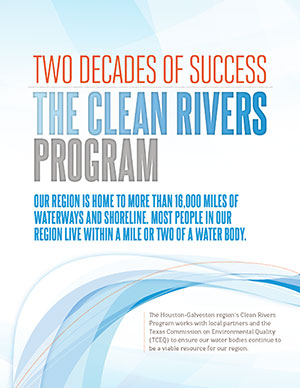Brochures and Outreach Materials
In support of the various public outreach and education activities, H-GAC staff develops resource materials to assist in encouraging behaviors that promote good water quality in the region.
The H-GAC CRP has provided up-to-date, quality-assured water quality data to its partners and stakeholders for more than 20 years, resulting in increased collaboration and more targeted public outreach activities. In recognition of this milestone, H-GAC developed “Two Decades of Success: The Clean Rivers Program” a tri-fold brochure sent to fee payers, elected officials, local partners, and supporters of H-GAC’s CRP in 2013. The brochure provides an overview of regional water quality concerns, partnership benefits, cost-savings measures that have been implemented, and other information on the H-GAC CRP.

In 2013, H-GAC purchased 10,000 pet waste bags and dispensers for outreach purposes. The pet waste bags are a tool for implementing best management practices regarding bacteria and are given to event attendees and booth participants who sign the Pet Waste Pollutes Pledge or play the Pitch the Poop interactive game.

The Galveston Bay Foundation, in partnership with Cease the Grease in the Dallas/Fort Worth area, launched a local version of a fats, oils and grease campaign for the Galveston Bay Watershed. H-GAC is a partner in this effort and produced outreach materials for the campaign that focused on the holiday season and proper disposal of cooking oils. In conjunction with Trash Bash®, a fats, oils, and grease interactive display was created.

Our Great Region 2040 is a high-level plan that focuses on economic development, the environment, healthy communities, housing, transportation, and resiliency in the Houston-Galveston region. In support of the plan, H-GAC CRP staff provided input on and assistance with the development of several major goals and strategies. One of the key goals of the plan is to secure a clean and ample water supply. With this goal in mind, staff and other interested stakeholders recommended strategies for inclusion in the plan that align with best management practices frequently recommended for protecting and preserving water quality. This project was completed in 2014.
